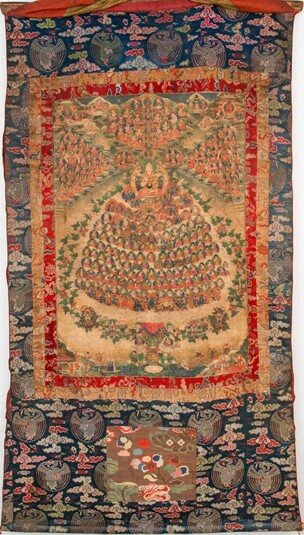
Item: Refuge Field (Buddhist) - Gelug Lineage
| Origin Location | Tibet |
|---|---|
| Date Range | 1700 - 1799 |
| Lineages | Gelug and Buddhist |
| Material | Ground Mineral Pigment on Cotton |
| Collection | Private |
Classification: Object/Concept
Tsongkapa: surrounded by lineage teachers above and to the sides with meditational deities and protectors below - the Field for the Accumulation of Merit (Tib.: tsog shing).
Tibetan: Tsog shing Tibetan: Lama Tsongkapa
Tibetan: Lama Tsongkapa
In the Gelug Tradition of Tibetan Buddhism there are numerous Refuge Field composition types distinguished both by central figure and by symbolic support (i.e. lotus, tree, or throne): (1) Shakyamuni Buddha, (2) Je Tsongkapa, (3) Pabongka Design, and (4) Lotus Support, and (5) Block Print. The first three types are depicted at the peak of a wish-fulfilling tree, seated on a throne and lotus. The fourth type is placed only on a lotus blossom. The two general types of central figures for all types of Refuge Fields are Shakyamuni Buddha and Je Tsongkapa. The variation of the two subject figures depend on the intention, purpose and function of the painting. The former is a Lama Chopa (Shakyamuni) Refuge Field and the latter a Lamrim Lineage (Tsongkapa) Refuge Field. The various Gelug Refuge Fields are a 17th century development based on the 15th and 16th century compositions of Tsongkapa and the Yogachara and Madhyamaka lineages.
This composition has Je Tsongkapa at the center with a small depiction of the Buddha at his heart. Directly above as a mass of figures is the direct transmission lineage of Manjushri along with Tantric lineage teachers. The two small rainbow circles on the right and left contain the Six Ornaments and Two Excellent Ones of the Southern Continent: Nagarjuna, Aryadeva, Asanga, Vasubandu, Dignaga and Dharmakirti. The Two Excellent Ones are: Gunaprabha and Shakyaprabha. These eight are the most distinguished scholarly Indian Buddhist teachers.
At the upper left is the Yogachara lineage originating with Arya Asanga. At the upper right is the Madyamaka lineage originating with Arya Manjushri.
Descending beneath the central figure of Tsongkapa are eleven rows of figures. The top four rows are Tantric meditational deities. Below that are the Thirty-five Confession Buddhas and the Eight Great Bodhisattvas. Below that are two rows of Arhats and the Sixteen Great Elders.Below that is the row of dakas and dakinis, viras and virinis. The very last row at the bottom is composed of the principal wisdom protectors of the Gelug tradition of Tibetan Buddhism. Again below that, outside of the lotus and throne, are the Four Direction Kings along with various offering goddesses. At the bottom right is a donor figure sitting in front of a shrine.
Jeff Watt 8-2017
Collection of Anna Maria Rossi & Fabio Rossi
Subject: Refuge Field, Gelug (Main Page)
Subject: Refuge Field, Gelug (Tsongkapa)

